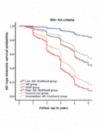Prevalence and prognosis of Alzheimer's disease at the mild cognitive impairment stage
- PMID: 25693589
- PMCID: PMC5013930
- DOI: 10.1093/brain/awv029
Prevalence and prognosis of Alzheimer's disease at the mild cognitive impairment stage
Abstract
Three sets of research criteria are available for diagnosis of Alzheimer's disease in subjects with mild cognitive impairment: the International Working Group-1, International Working Group-2, and National Institute of Aging-Alzheimer Association criteria. We compared the prevalence and prognosis of Alzheimer's disease at the mild cognitive impairment stage according to these criteria. Subjects with mild cognitive impairment (n = 1607), 766 of whom had both amyloid and neuronal injury markers, were recruited from 13 cohorts. We used cognitive test performance and available biomarkers to classify subjects as prodromal Alzheimer's disease according to International Working Group-1 and International Working Group-2 criteria and in the high Alzheimer's disease likelihood group, conflicting biomarker groups (isolated amyloid pathology or suspected non-Alzheimer pathophysiology), and low Alzheimer's disease likelihood group according to the National Institute of Ageing-Alzheimer Association criteria. Outcome measures were the proportion of subjects with Alzheimer's disease at the mild cognitive impairment stage and progression to Alzheimer's disease-type dementia. We performed survival analyses using Cox proportional hazards models. According to the International Working Group-1 criteria, 850 (53%) subjects had prodromal Alzheimer's disease. Their 3-year progression rate to Alzheimer's disease-type dementia was 50% compared to 21% for subjects without prodromal Alzheimer's disease. According to the International Working Group-2 criteria, 308 (40%) subjects had prodromal Alzheimer's disease. Their 3-year progression rate to Alzheimer's disease-type dementia was 61% compared to 22% for subjects without prodromal Alzheimer's disease. According to the National Institute of Ageing-Alzheimer Association criteria, 353 (46%) subjects were in the high Alzheimer's disease likelihood group, 49 (6%) in the isolated amyloid pathology group, 220 (29%) in the suspected non-Alzheimer pathophysiology group, and 144 (19%) in the low Alzheimer's disease likelihood group. The 3-year progression rate to Alzheimer's disease-type dementia was 59% in the high Alzheimer's disease likelihood group, 22% in the isolated amyloid pathology group, 24% in the suspected non-Alzheimer pathophysiology group, and 5% in the low Alzheimer's disease likelihood group. Our findings support the use of the proposed research criteria to identify Alzheimer's disease at the mild cognitive impairment stage. In clinical settings, the use of both amyloid and neuronal injury markers as proposed by the National Institute of Ageing-Alzheimer Association criteria offers the most accurate prognosis. For clinical trials, selection of subjects in the National Institute of Ageing-Alzheimer Association high Alzheimer's disease likelihood group or the International Working Group-2 prodromal Alzheimer's disease group could be considered.
Keywords: Alzheimer’s disease; MCI; biomarkers; diagnostic criteria; prognosis.
© The Author (2015). Published by Oxford University Press on behalf of the Guarantors of Brain. All rights reserved. For Permissions, please email: journals.permissions@oup.com.
Figures



Comment in
-
New criteria for Alzheimer's disease: which, when and why?Brain. 2015 May;138(Pt 5):1134-7. doi: 10.1093/brain/awv055. Brain. 2015. PMID: 25907755 Free PMC article.
Similar articles
-
The frequency and influence of dementia risk factors in prodromal Alzheimer's disease.Neurobiol Aging. 2017 Aug;56:33-40. doi: 10.1016/j.neurobiolaging.2017.03.034. Epub 2017 Apr 8. Neurobiol Aging. 2017. PMID: 28482212
-
Research diagnostic criteria for Alzheimer's disease: findings from the LipiDiDiet randomized controlled trial.Alzheimers Res Ther. 2021 Mar 25;13(1):64. doi: 10.1186/s13195-021-00799-3. Alzheimers Res Ther. 2021. PMID: 33766132 Free PMC article. Clinical Trial.
-
Injury markers but not amyloid markers are associated with rapid progression from mild cognitive impairment to dementia in Alzheimer's disease.J Alzheimers Dis. 2012;29(2):319-27. doi: 10.3233/JAD-2011-111694. J Alzheimers Dis. 2012. PMID: 22233766
-
[The new 2011 recommendations of the National Institute on Aging and the Alzheimer's Association on diagnostic guidelines for Alzheimer's disease: Preclinal stages, mild cognitive impairment, and dementia].Rev Neurol (Paris). 2012 Jun;168(6-7):471-82. doi: 10.1016/j.neurol.2011.11.007. Epub 2012 May 12. Rev Neurol (Paris). 2012. PMID: 22579080 Review. French.
-
Prevalence and risk of progression of preclinical Alzheimer's disease stages: a systematic review and meta-analysis.Alzheimers Res Ther. 2019 Jan 15;11(1):7. doi: 10.1186/s13195-018-0459-7. Alzheimers Res Ther. 2019. PMID: 30646955 Free PMC article.
Cited by
-
Biomarkers and Tools for Predicting Alzheimer's Disease in the Preclinical Stage.Curr Neuropharmacol. 2022;20(4):713-737. doi: 10.2174/1570159X19666210524153901. Curr Neuropharmacol. 2022. PMID: 34030620 Free PMC article.
-
Impact of financial barriers on health status, healthcare utilisation and economic burden among individuals with cognitive impairment: a national cross-sectional survey.BMJ Open. 2022 May 4;12(5):e056466. doi: 10.1136/bmjopen-2021-056466. BMJ Open. 2022. PMID: 35508339 Free PMC article.
-
Phases of Hyperconnectivity and Hypoconnectivity in the Default Mode and Salience Networks Track with Amyloid and Tau in Clinically Normal Individuals.J Neurosci. 2017 Apr 19;37(16):4323-4331. doi: 10.1523/JNEUROSCI.3263-16.2017. Epub 2017 Mar 17. J Neurosci. 2017. PMID: 28314821 Free PMC article.
-
24-month intervention with a specific multinutrient in people with prodromal Alzheimer's disease (LipiDiDiet): a randomised, double-blind, controlled trial.Lancet Neurol. 2017 Dec;16(12):965-975. doi: 10.1016/S1474-4422(17)30332-0. Epub 2017 Oct 30. Lancet Neurol. 2017. PMID: 29097166 Free PMC article. Clinical Trial.
-
Circulating brain-enriched microRNAs as novel biomarkers for detection and differentiation of neurodegenerative diseases.Alzheimers Res Ther. 2017 Nov 9;9(1):89. doi: 10.1186/s13195-017-0316-0. Alzheimers Res Ther. 2017. PMID: 29121998 Free PMC article.
References
-
- American Psychiatric Association. Washington, DC: American Psychiatric Association; 1994. Diagnostic and Statistical Manual of Mental Disorders: DSM-IV.
-
- Baldeiras I, Santana I, Proença MT, Garrucho MH, Pascoal R, Rodrigues A, et al. Peripheral oxidative damage in mild cognitive impairment and mild Alzheimer’s disease. J Alzheimers Dis. 2008;15:117–28. - PubMed
-
- Bastin C, Kerrouche N, Lekeu F, Adam S, Guillaume B, Lemaire C, et al. Controlled memory processes in questionable Alzheimer's disease: a view from neuroimaging research. J Alzheimers Dis. 2010;20:547–60. - PubMed
-
- Bouwman FH, Verwey NA, Klein M, Kok A, Blankenstein MA, Sluimer JD, et al. New research criteria for the diagnosis of Alzheimer’s disease applied in a memory clinic population. Dement Geriatr Cogn Disord. 2010;30:1–7. - PubMed
Publication types
MeSH terms
Substances
Grants and funding
LinkOut - more resources
Full Text Sources
Other Literature Sources
Medical

